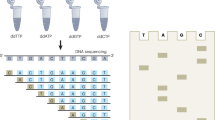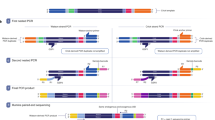Abstract
First-generation automated DNA sequencers are based on operations, manipulations, and methodologies not unlike those performed by their human predecessors. While these instruments may reduce labor, they do not increase sequencing rates by exponential factors. Here we review several new methodologies that could enhance sequencing rates by orders-of-magnitude. From the perspective of combining separate techniques into future second generation sequencers, we review: (1) multispectral sequencing, (2) fluorophore photochemistry, (3) multiplex sequencing, (4) direct blotting electrophoresis, and (5) electronic imaging techniques. Hardware and an operational protocol (including a novel kit of primers and probes) are proposed for a multispectral-multiplex sequencer, capable of processing one million DNA bases per sequencing gel blot.
This is a preview of subscription content, access via your institution
Access options
Subscribe to this journal
Receive 12 print issues and online access
$209.00 per year
only $17.42 per issue
Buy this article
- Purchase on Springer Link
- Instant access to full article PDF
Prices may be subject to local taxes which are calculated during checkout
Similar content being viewed by others
References
Mapping and Sequencing the Human Genome 1988. National Academy Press.
Martin, W.J. and Davies, R.W. 1986. Automated DNA sequencing: Progress and Prospects. Bio/Technology 4:890–895.
Wada, A. 1987. Automated high-speed DNA sequencing. Nature 325:771–772.
Landegren, U., Kaiser, R., Caskey, C.T. and Hood, L. 1988. DNA diagnostics—Molecular techniques and automation. Science 242:229–237.
Maxam, A.M. and Gilbert, W. 1977. A new method for sequencing DNA. Proc. Nat. Acad. Sci. USA 74:560–564.
Sanger, F., Nicklen, S. and Coulson, A.R. 1977. DNA sequencing with chain-terminating inhibitors. Proc. Nat. Acad. Sci. USA 74:5463–5467.
Smith, L.M., Fung, S., Hunkapiller, M.W., Hunkapiller, T.J. and Hood, L.E. 1985. The synthesis of oligonucleotides containing an aliphatic amino group at the 5′ terminus: synthesis of fluorescent DNA primers for use in DNA sequence analysis. Nuc. Acids Research 13:2399–2412.
Smith, L.M., Sanders, J.Z., Kaiser, R.J., Hughes, P., Dodd, C., Connell, C.R., Heiner, C., Kent, S.B.H. and Hood, L.E. 1986. Fluorescence detection in automated DNA sequence analysis. Nature 321:674–679.
Prober, J.M., Trainor, G.L., Dam, R.J., Hobbs, F.W., Robertson, C.W., Zagursky, R.J., Cocuzza, A.J., Jensen, M.A. and Baumeister, K. 1987. A system for rapid DNA sequencing with fluorescent chain-terminating dideoxynucleotides. Science 238:336–341.
Ansorge, W., Sproat, B.S., Stegemann, J. and Schwage, C.J. 1986. A non-radioactive automated method for DNA sequence determination. Biochem. Biophy. Methods 13:315–323.
Ansorge, W., Sproat, B., Stegemann, J., Schwager, C. and Zenke, M. 1987. Automated DNA sequencing; ultrasensitive detection of fluorescent bands during electrophoresis. Nuc. Acids Research 15:4593–4602.
Brumbaugh, J.A., Middendorf, L.R., Grone, D.L. and Ruth, J.L. 1988. Continuous, on-line DNA sequencing using oligodeoxynucleotide primers with multiple fluorophores. Proc. Nat. Acad. Sci. USA 85:5610–5614.
Kambara, H., Nishikawa, T., Katayama, Y. and Yamaguchi, T. 1988. Optimization of parameters in a DNA sequenator using fluorescence detection. Bio/Technology 6:816–821.
Mathies, R.A. and Stryer, L. Single molecule fluorescence detection: a feasibility study using phycoerythrin, p. 129–140. In: Applications of Fluorescence in the Biomedical Sciences. Alan R. Liss, Inc., NY.
Turro, N.J. 1978. Modern Molecular Photochemistry. Benjamin/Cummings Pub. Co.
Glazer, A.N. and Stryer, K. 1984. Phycofluor probes, TIBS Oct.: 423–427.
White, J.C. and Stryer, L. 1987. Photostability studies of phycobiliprotein fluorescent labels. Anal. Biochem. 161:442–452.
Church, G.M. and Gilbert, W. 1984. Genomic sequencing. Proc. Nat. Acad. Sci. USA 81:1991–1995.
Church, G.M. and Kieffer-Higgins, S. 1988. Multiplex DNA sequencing. Science 240:185–188.
Beck, S. and Pohl, F.M. 1984. DNA sequencing with direct blotting electrophoresis. EMBO J. 3:2905–2909.
Beck, S. 1988. Protein blotting with direct blotting electrophoresis. Anal. Biochem. 170:361–366.
UCLA forum in the medical sciences 9. Image Processing in Biological Science. 1968. D. M. Ramsey (Ed). Univ. of California Press.
Inoue, S., 1986. Video Microscopy, Plenum Press, New York.
Elder, J.K., Green, D.K. and Southern, E.M. 1986. Automatic reading of DNA sequencing gel autoradiographs using a large format digital scanner. Nuc. Acids Research 14:417–424.
Gray, A.J., Beecher, D.E. and Olson, M.V. 1984. Computer-based image analysis of one-dimensional electrophoretic gels used for the separation of DNA restriction fragments. Nuc. Acids Research 12:473–491.
Sutherland, J.C., Lin, B., Monteleone, D.C., Mugavero, J., Sutherland, B.M. and Trunk, J. 1987. Electronic imaging system for direct and rapid quantitation of fluorescence from electrophoretic gels: Application to ethidium bromide-stained DNA. Anal. Biochem. 163:446–457.
Gonzalez, R.C. and Wintz, P. 1987. Digital Image Processing. Addison-Wesley.
Yang, M.M. and Youvan, D.C. 1988. Applications of imaging spectroscopy in molecular biology: 1. Screening photosynthetic bacteria. Bio/Technology 6:939–942.
Yang, M.M. and Youvan, D.C. 1989. In preparation.
Waggoner, A.S. 1986. Fluorescent probes for analysis of cell structure, function, and health by flow and imaging cytometry, p. 3–28. In: Applications of Fluorescence in the Biomedical Sciences. Alan R. Liss, Inc.
Hemmila, I., Dakubu, S., Mukkala, V., Siitari, H. and Lovgren, T. 1984. Europium as a label in time-resolved immunofluorometric assays. Anal. Biochem. 137:335–343.
Oser, A., Roth, W.K. and Valet, G. 1988. Sensitive non-radioactive dot-blot hybridization using DNA probes labelled with chelate group substituted psoralen and quantitative detection by europium ion fluorescence. Nuc. Acids Research 16:1181–1196.
Author information
Authors and Affiliations
Rights and permissions
About this article
Cite this article
Yang, M., Youvan, D. A Prospectus for Multispectral-Multiplex DNA Sequencing. Nat Biotechnol 7, 576–580 (1989). https://doi.org/10.1038/nbt0689-576
Issue Date:
DOI: https://doi.org/10.1038/nbt0689-576
This article is cited by
-
A Prospectus for Multispectral-Multiplex DNA Sequencing
Nature Biotechnology (1989)



